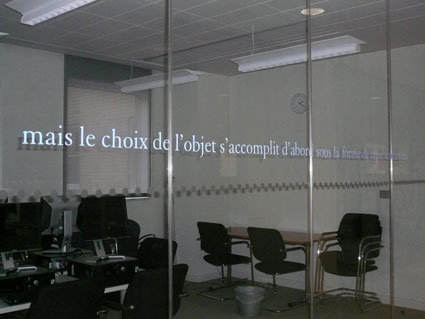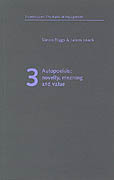|
|
|||||||
|
PROJECTSBlazers/ /Blasons
Download a pdf here.
Their eyes travel across the pages and their hearts search out meaning, convened by Sami Jalili and Sharon Kivland, with Mura Ghosh. An evening of readings and performances at Senate House Library, from 6.00 to 7.30 p.m. on Saturday 26 April Library Interventions
Transcript In the third edition of The Interpretation of Dreams, Freud adds the observation: ‘It is impossible to translate a dream into a foreign language’ (1900, p. 99, fn. 1). In a letter of 13th April 1911, to Samuel Jankelévitch, he remarks that his dream book seems to him to be untranslatable because of its dream texts, and if a translation were to be done, he feels it would probably scare French people away from further reading. Transcript is a project of impossible interpretation and translation, taking texts à la lettre and avant la lettre. 1. Walbaum, Caslon, Garamond a dream is the fulfillment of a wish.
the finding of an object is in fact a refinding of it
it is in the world of ideas, however, that the choice of an object is accomplished at first
neuroses are, so to say, the negative of perversions
La passante ongoing Sharon Kivland continues to haunt the arcades of Paris in search of her subjects.
Transmission: Speaking and Listening The Transmission series is a collaboration between Site Gallery, Sheffield Hallam University School of Cultural Studies and the Showroom Cinema, in which invited artists and occasionally speakers from other disciplines, present a discourse on their practices in relation to a given theme. Opening up the debate to a wider audience the subsequent discussions form part of a publication. Although the lectures are absent from the publication, the speakers retain their presence in other ways; through short introductory texts to their practice, works conceived for the pages, and as a dialogue with others. Transmission: Speaking and Listening Volume 1 Contributors: Two essays, by Jane Rendell and Duncan McLaren frame the discussions. The essays, like the discussions, explore what it means to speak, to listen, and to construct meaning or work in the interstice between the two. Transmission: Speaking and Listening Volume 2 Although the lectures are absent from this book, the speakers retain their presence in other ways; through short introductory texts to their practice, works conceived for the pages, and as a dialogue with others. Four essays by Darian Leader, Sarah Wigglesworth, Michael Archer & Clementine Deliss frame the discussions. The essays, like the discussions, explore what it means to speak, to listen, and to construct meaning or work in the interstice between the two. Transmission: Speaking and Listening Volume 3 Contributors: Jananne Al-Ani, David Bate, Kate Blacker, Kathrin Böhm,
Pavel Büchler, Conroy / Sanderson, Mikey Cuddihy, Eggebert-and-Gould,
Dan Hays, David Mabb, Monica Oechsler, Simon Periton, Paul Rooney, George
Shaw, Sarah Staton, Jemima Stehli This volume takes up two themes: Ornament and Utility, which addresses the question of aesthetic judgement and the use (or usefulness) of a work of art; and Responsibility, which considers the ideology of artistic production.
Contributors: Gabriel Gbadamosi, Christopher Landoni, Goshka Macuga, Elizabeth Price, Nigel Cooke, Julian Walker, Nick Stewart, Steve Edwards, Simon Morris, Victor Burgin, Mark Titchner, ArtLab, C. Cullinan and J. Richards, Lucy Harrison, Brigid McLeer, Vera Dieterich and Caroline Rooney, Jane Rendell, Sally O’Reilly, and Pavel Büchler. This volume takes up two themes: Provenance, which generally means the place of origin, and here takes on rather more complex meanings in relation to art and art objects, and the market or value systems that contain them; and Inscription, which addresses the reading of works of art, when they are produced as texts or incorporate text within them. Also included is a symposium on Inscription.
Contributors: Jaspar Joseph-Lester, Becky Shaw, Ryan Gander, Neal Rock, Imogen Stidworthy, Neil Cummings and Marysia Lewandowska, Nayan Kulkarni, Mike Marshall, Carey Young, Dave Beech, Robert Milin, Doug Fishbone, Richard Wentworth, Hewitt and Jordan, Malcolm Miles, Amanda Beech, and Chris Oakley. Volume 5 addresses the habits and rituals shaping our everyday lives, and their relation with art. When taken out of the context of the everyday and made into works of art, those practices that we perceive as natural or real appear as constructed fabrications. In exploring the theme of daily encounters , artists and writers address the ways in which art may provoke and antagonize patterns of behaviour and systems of belief that often remain unquestioned. The contributors consider how works of art appropriate and re-deliver the naturalized and the everyday as a series of fictions and, in so doing, reflect the mechanisms and frameworks constructing our lives.
The publication series is edited by Sharon Kivland; the programme was co-ordinated by Lesley Sanderson and Sharon Kivland, with Site Gallery and subsequently co-ordinated by Emma Cocker, Jaspar Joseph-Lester and Sharon Kivland. Designed by Patrick Ward with Ben Weaver, the books are distributed by Cornerhouse Publications www.cornerhouse.org
Transmission: The Rules of Engagement Series Editors: Sharon Kivland and Ben Hillwood-Harris Available from Art Words On Record: Advertising,Architecture and the Actions of Gina Pane Disorientation and spectacle in retail archictecture Book unbinding: the ontological stain Sharing an interest in the operation of weaving with regard to textual materialism and material text, the authors follow the operation of folding, cutting and biding, the operations that constitute the making of a book. The work contains two main sections, one on folding and the other on cutting, with a concluding section on binding. The sections on folding and cutting dramatize two approaches to the entanglements of thought, reflection and aesthetic practice. In the first, precedence is given to a conceptual elaboration of the fold in parallel with the reservations of an art of the fold that resists formalisation. The philosophical concentration on a logic of form in relation to practice and questions of process is deconstructed. Whilst the first section traces a philosophical and scientific investment in pre-established design, the second ruins this through attending to the possibilities that arise through cutting, generic interplay and bricolage. The book unbinds as it works from the tightly woven to a loosening of its threads, where finally the book cannot contain the book. Misleading epiphenomena Misleading epiphenomena takes Park Hill, a one-thousand-unit housing estate designed between 1957 and 1960 by Sheffield City Council, as the prompt for observations and conversations, addressing questions as varied as northern identity, architectural modernism, corporation, social housing, the sublime, ruin, the uncanny, aura, entropy, writing and the disciplinary limits of the authors. While Park Hill is the ‘site’ of encounter, reflection and inversion emerge as the processes and methods of exchange. Sun-Shine, Moonshine In Sun-Shine, Moonshine, Conroy / Sanderson and Gabriel Gbadamosi take up and challenge the rules of engagement, making up their own conventions as they go along. The text and images were developed over six months, in dialogues that took place both in the artists' studio and elsewhere. Images were made in response to conversations and writings were constructed on images, which then returned to visual representation. The work is founded on Jonathan Swift's satire Gulliver's Travels, and, like Swift, the authors reflect on identity and difference, the foreign and the far-fetched. In an entwining of text and image, figures (as tropes and real people) playing Gulliver (as tourist, stranger, lover or other) float disappear, double and mirror each other. Analysis Analysis is a collectively authored text examining contemporary collaborative art practice whilst grounding authorship in a social ontology. Despite the 'death of the author', the artist remains a possesive individual. Even collaborative practices - which Analysis differentiates from collective - confirm this, comprising individuals pooling their resourses only to serve their common private interests, effectively continuing to treat individuals as the basic social unit. Collectivity, Analysis argues, inverts this formula, treating the social as the basic unit from which the individual arises. It is the latter, therefore, that has the potential to transcend possesive individualism for contemporary art. The Blue Guitar The blue guitar is you. It shapes you. As surprise, by surprising you. You collaborate and lay hands on this guitar, sometimes reject it but cannot escape the delicacy of its riffs and affirmations. Whether it comes from Picasso, Michael Tippett, Derek Bailey, Rilke or Jacques Derrida, the blue guitar is a thing affirmed, a yes played over a final no. This book is a book is a book of comical roots: super-roots, radishes, beetroots, gooseberries, bobby dazzlers, and seabows. It is a prison book, a book of legend and song, a picture book, a book of the same, of affirmations as colours. It is a book of the freshly rooted and radically purposeful in poetry, figured out here by Wallace Stevens and his poem 'The Man with the Blue Guitar.' The slender margin between the real and the unreal Chikamatsu Monazaemon (1653-1724) comments that 'art is something that lies in the slender margin between the real and the unreal'. This is the origin of a discussion which recalls the experience and associated imaginings of the European gardens of the seventeenth and eighteenth century and their distant cousins, the stroll gardens of the Tokogawa and Meji periods of Japan. The shared use of the borrowed landscape or 'shakkei' allows for further enquiry into the similarities and difference. The three authors, through discussion, correspondence, and visits to particular gardens, built a relationship through the sharing of references and experiences.The garden reveals itself as a bountiful source of inspiration, a place of escapism, a cultural and social signifier, and as a place for thinking Shadows What did the chained men in Plato's allegory of the cave see when they looked at the shadows on the wall? Did they see pictures of the world or rather, reflections of their own imagination? What is the difference? Shadows examines the relation between image and mind from the point of view of the scientific image-archive and from the image-repertoire of a number of artists. Each of these perspectives shows a bond between perception and production, while simultaneously revealing an element that appears to be inexplicable, an enigmatic gap that may provide a key to the way we view the world and its images, the cave and its shadows. Non-relational Aesthetics 'Relational Art' and 'relational aesthetics' are commonplace terms in contemporary art discourse. Defined as a 'set of artistic practices which take as their theoretical and practical point of departure the whole of human relations and their social context, rather than an independent and private space' and as an aesthetic theory consisting in judging art works on the basis of the inter-human relations which they represent, produce or prompt'. In such an aesthetics, art is seemingly required to act as a replacement for the binding of the community through the rituals of religion.Non-relational Aesthetics proposes that all discourse involves alterity, difference and deferral. Non-relational Aesthetics offers a concept of art as an ethical encounter with the other, and the idea of art as 'hospitality' is anticipated as an alternative to that of 'relational aesthetics.'
Transmission: Host Host: Bound Edition 2008 The host selects and presents his or her guest. A critical engagement between host and guest is assumed; what exactly that relationship is made evident through discussion. There is an ethics of hospitality, of making the stranger welcome. A host has a standard of conduct, and historically, hospitality has been seen as a code, a duty, a virtue, and a law. There is a bond between host and guest, and here, the bond is formed by the engagement in the practice of art. Something is shared between host and guest, and this is shared with others, who are guests as well. The audience is also a host, with all the responsibilities that implies, receiving the stranger/guest with goodwill, liberality, and grace. 1. Host: Paul Haywood & Steve Hawley
|
||||||












